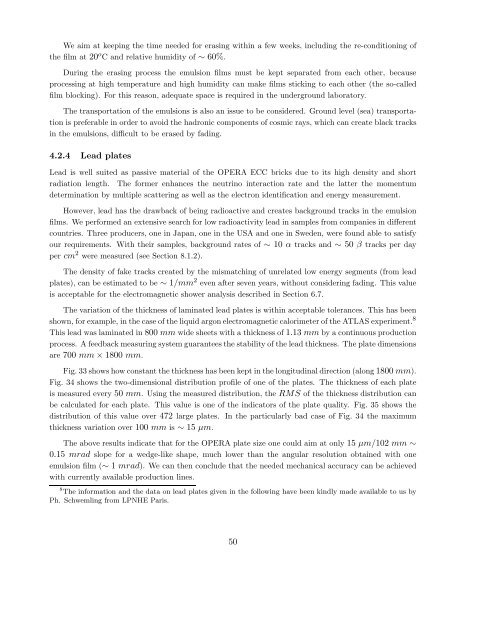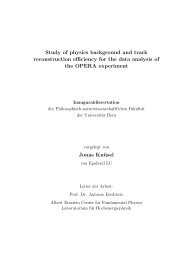Experiment Proposal - opera - Infn
Experiment Proposal - opera - Infn
Experiment Proposal - opera - Infn
You also want an ePaper? Increase the reach of your titles
YUMPU automatically turns print PDFs into web optimized ePapers that Google loves.
We aim at keeping the time needed for erasing within a few weeks, including the re-conditioning of<br />
the film at 20 o C and relative humidity of ∼ 60%.<br />
During the erasing process the emulsion films must be kept separated from each other, because<br />
processing at high temperature and high humidity can make films sticking to each other (the so-called<br />
film blocking). For this reason, adequate space is required in the underground laboratory.<br />
The transportation of the emulsions is also an issue to be considered. Ground level (sea) transportation<br />
is preferable in order to avoid the hadronic components of cosmic rays, which can create black tracks<br />
in the emulsions, difficult to be erased by fading.<br />
4.2.4 Lead plates<br />
Lead is well suited as passive material of the OPERA ECC bricks due to its high density and short<br />
radiation length. The former enhances the neutrino interaction rate and the latter the momentum<br />
determination by multiple scattering as well as the electron identification and energy measurement.<br />
However, lead has the drawback of being radioactive and creates background tracks in the emulsion<br />
films. We performed an extensive search for low radioactivity lead in samples from companies in different<br />
countries. Three producers, one in Japan, one in the USA and one in Sweden, were found able to satisfy<br />
our requirements. With their samples, background rates of ∼ 10 α tracks and ∼ 50 β tracks per day<br />
per cm 2 were measured (see Section 8.1.2).<br />
The density of fake tracks created by the mismatching of unrelated low energy segments (from lead<br />
plates), can be estimated to be ∼ 1/mm 2 even after seven years, without considering fading. This value<br />
is acceptable for the electromagnetic shower analysis described in Section 6.7.<br />
The variation of the thickness of laminated lead plates is within acceptable tolerances. This has been<br />
shown, for example, in the case of the liquid argon electromagnetic calorimeter of the ATLAS experiment. 8<br />
This lead was laminated in 800 mm wide sheets with a thickness of 1.13 mm by a continuous production<br />
process. A feedback measuring system guarantees the stability of the lead thickness. The plate dimensions<br />
are 700 mm × 1800 mm.<br />
Fig. 33 shows how constant the thickness has been kept in the longitudinal direction (along 1800 mm).<br />
Fig. 34 shows the two-dimensional distribution profile of one of the plates. The thickness of each plate<br />
is measured every 50 mm. Using the measured distribution, the RMS of the thickness distribution can<br />
be calculated for each plate. This value is one of the indicators of the plate quality. Fig. 35 shows the<br />
distribution of this value over 472 large plates. In the particularly bad case of Fig. 34 the maximum<br />
thickness variation over 100 mm is ∼ 15 µm.<br />
The above results indicate that for the OPERA plate size one could aim at only 15 µm/102 mm ∼<br />
0.15 mrad slope for a wedge-like shape, much lower than the angular resolution obtained with one<br />
emulsion film (∼ 1 mrad). We can then conclude that the needed mechanical accuracy can be achieved<br />
with currently available production lines.<br />
8 The information and the data on lead plates given in the following have been kindly made available to us by<br />
Ph. Schwemling from LPNHE Paris.<br />
50




